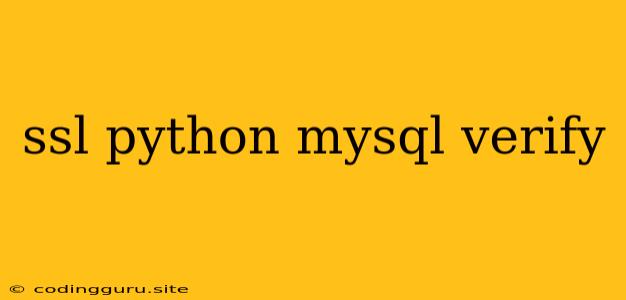Ensuring Secure Connections with SSL in Python and MySQL
Securing your database connections is paramount in any application development. The use of SSL (Secure Sockets Layer) provides a crucial layer of encryption to protect sensitive data exchanged between your Python application and your MySQL database. This article will guide you through the process of establishing a secure connection using SSL within your Python code.
Why Use SSL for MySQL Connections?
Connecting to a MySQL database over a regular TCP/IP connection leaves your data vulnerable to eavesdropping and potential manipulation during transmission. Imagine your application sending sensitive user information like passwords or financial details over an unsecured channel - anyone with access to the network could intercept and potentially exploit this information.
SSL addresses this vulnerability by encrypting the communication between your application and the database server. This ensures that only the intended recipient can decipher the transmitted data, safeguarding its integrity and confidentiality.
Essential Steps to Configure SSL
1. Obtain SSL Certificates:
-
Your MySQL database server needs a valid SSL certificate to establish secure connections. You can either obtain a certificate from a trusted Certificate Authority (CA) or generate a self-signed certificate for testing purposes.
-
If you're using a cloud-based database service, the provider often offers built-in SSL support. Consult their documentation for instructions on enabling SSL.
2. Configure MySQL Server:
-
Once you have the necessary certificates, you need to configure your MySQL server to enable SSL connections.
-
This usually involves:
- Specifying the path to the SSL certificates (e.g.,
ssl-ca,ssl-cert,ssl-key) in the MySQL configuration file (my.cnformy.ini). - Enabling SSL support by setting
ssl=1. - Restarting the MySQL server to apply the changes.
- Specifying the path to the SSL certificates (e.g.,
3. Configure Python Client:
-
In your Python code, you need to establish a connection to the MySQL database using the appropriate library (e.g.,
mysql-connector-python,PyMySQL). -
Here's a basic example using
mysql-connector-python:
import mysql.connector
# SSL configuration
ssl_config = {
'ca': 'path/to/ca_cert.pem', # Path to the CA certificate
'cert': 'path/to/client_cert.pem', # Path to your client certificate
'key': 'path/to/client_key.pem', # Path to your client key
}
# Establish connection with SSL enabled
mydb = mysql.connector.connect(
host="your_host",
user="your_user",
password="your_password",
database="your_database",
ssl_ca=ssl_config['ca'],
ssl_cert=ssl_config['cert'],
ssl_key=ssl_config['key']
)
- This code snippet demonstrates how to configure the
mysql.connectorlibrary to connect to a MySQL server using SSL. You'll need to replace the placeholder values with your actual connection details and certificate paths.
Verifying the SSL Connection
After configuring both the MySQL server and your Python client, it's crucial to verify that the connection is indeed using SSL. You can achieve this using the following methods:
-
MySQL Server Logs: Examine the MySQL server logs (usually found in
/var/log/mysql/) for messages indicating successful SSL handshakes. Look for lines containing "SSL connection". -
Python Code: You can check the
mydb.is_connected()attribute in your Python code. This returnsTrueif a connection is established. However, this doesn't guarantee SSL is active. -
SSL/TLS Handshake Analyzer: Use network monitoring tools like Wireshark to capture and analyze the network traffic between your Python application and the MySQL server. This will provide detailed information about the SSL handshake process and confirm that the connection is indeed secured.
Troubleshooting SSL Issues
-
Certificate Validation Errors: Ensure that the certificates you're using are valid and trusted. Check the certificate expiration date and ensure the CA is recognized by your system.
-
Incorrect Path or File Permissions: Verify that the paths to the SSL certificates are correct and that the files have appropriate read permissions for your MySQL server and Python client.
-
SSL Configuration: Double-check the SSL configuration settings in your MySQL server's configuration file (
my.cnformy.ini). Ensure that the SSL settings are enabled and correctly configured. -
Firewall Rules: If you're using a firewall, make sure it allows connections to the MySQL server on the appropriate ports.
-
Missing Libraries: Ensure that the necessary Python libraries (e.g.,
mysql-connector-python) are installed and that their versions are compatible with your MySQL server version.
Conclusion
By implementing SSL for your MySQL connections, you can significantly strengthen the security of your applications and protect sensitive data. Remember to follow best practices like using valid and trusted certificates, configuring your MySQL server and Python client appropriately, and verifying the SSL connection. By adhering to these steps, you'll be well on your way to securing your data and ensuring a robust and reliable connection between your Python application and your MySQL database.
